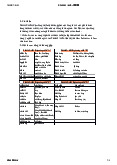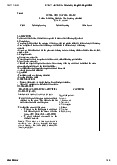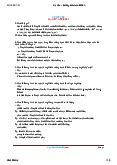




Preview text:
Tiếng anh chuyên ngành – Takenote
- The article written by __ (on + date/newspaper) talks about __wh__. Wh- what/who/where/why/how Fundamental = basic/essential
Endorsement = approvement/ verification Recommendation = suggestion/ Potential = possible/ target Dedicated – tận tâm
Niche – nhu cầu tiêu thụ
Drive awareness = tell the customer= get attention
Promote the company – move the business forwards Retain = continue to hold
Leverage – use sth to maximum advantage
Bleeding-edge= new/ experimental
Assertion = confident statement of fact -sự khẳng định
Indicator = trend or fact to meassure the level of something Tuần 2
Mate = to have sex and produce young, or to make animals do this, an animal's sexual partner
Offspring= the young of an animal
Caribou = a large deer with long horns with branches that lives in North America
Tundra = the very large area of land in North Asia, North America, and northern
Europe where, because it is cold, trees do not grow and ground below the
surface is permanently frozen- vùng lãnh nguyên 2.
Five types of animals : - Mammals - Birds - Reptiles – bò sát - Amphibians- lưỡng cư - Fish
- Invertebrates – loài không xương
Reasons why animals migrate?- find food or more livable conditions
Some animals migrate to breed. Frogs and toads often move very short
distances to breeding ponds and lakes to lay their eggs. Some sea turtles,
like the loggerhead, return year-after-year to the same sandy beach on
which they hatched to lay their eggs.
Sometimes animals migrate to find a place to hibernate. . Little brown bats
To travel to a warmer location
- balancing act : a difficult situation in which someone has to try to give
equal amounts of importance, time, attention, etc. to two or more different things at the same time
Causes of climate change - Greenhouse gases - Burning fossil fuels
- Deforestation Cutting them down means that carbon dioxide builds up
quicker since there are no trees to absorb it.
- Powering building- as they continue to draw on coal, oil, and natural gas
for heating and cooling, they emit significant quantities of greenhouse gas emissions.
Effect of climate change
- Higher temperatures increase heat-related illnesses and
make working outdoors more difficult. Wildfires start more
easily and spread more rapidly when conditions are hotter.
Temperatures in the Arctic have warmed at least twice as fast as the global average.
Animals which are not able to adopt to the changes will die or
- More severe storms -The frequency and extent of tropical storms is also
affected by the warming ocean. Cyclones, hurricanes, and typhoons feed on
warm waters at the ocean surface. Such storms often destroy homes and
communities, causing deaths and huge economic losses.
- Increased drought: Global warming exacerbates water shortages in
already water-stressed regions and is leading to an increased risk of
agricultural droughts affecting crops, and ecological droughts increasing
the vulnerability of ecosystems.
- Not enough food isheries, crops, and livestock may be destroyed or
become less productive. With the ocean becoming more acidic, marine
resources that feed billions of people are at risk. Changes in snow and ice
cover in many Arctic regions have disrupted food supplies from herding,
hunting, and fishing. Heat stress can diminish water and grasslands for
grazing, causing declining crop yields and affecting livestock.
- Loss of species Climate change poses risks to the survival of species on
land and in the ocean. These risks increase as temperatures climb. Forest
fires, extreme weather, and invasive pests and diseases are among many
threats related to climate change. Some species will be able to relocate
and survive, but others will not. Solutions
- Keep fossil fuels in the ground. Fossil fuels include coal, oil and gas – and
the more that are extracted and burned, the worse climate change will get.
All countries need to move their economies away from fossil fuels as soon as possible.
- Invest in renewable energy. Changing our main energy sources to clean
and renewable energy is the best way to stop using fossil fuels. These
include technologies like solar, wind, wave, tidal and geothermal power.
- Switch to sustainable transport. Petrol and diesel vehicles, planes and
ships use fossil fuels. Reducing car use, switching to electric vehicles and
minimising plane travel will not only help stop climate change, it will reduce air pollution too.
- Help us keep our homes cosy. Homes shouldn’t be draughty and cold –
it’s a waste of money, and miserable in the winter. The government can
help households heat our homes in a green way – such as by insulating
walls and roofs and switching away from oil or gas boilers to heat pumps.
- Improve farming and encourage vegan diets. One of the best ways for
individuals to help stop climate change is by reducing their meat and
dairy consumption, or by going fully vegan. Businesses and food retailers
can improve farming practices and provide more plant-based products to help people make the shift.
- Restore nature to absorb more carbon. The natural world is very good at
cleaning up our emissions, but we need to look after it. Planting trees in
the right places or giving land back to nature through ‘rewilding’ schemes
is a good place to start. This is because photosynthesising plants draw
down carbon dioxide as they grow, locking it away in soils.
- Protect forests like the Amazon. Forests are crucial in the fight against
climate change, and protecting them is an important climate solution.
Cutting down forests on an industrial scale destroys giant trees which
could be sucking up huge amounts of carbon. Yet companies destroy
forests to make way for animal farming, soya or palm oil plantations.
Governments can stop them by making better laws.
- Protect the oceans. Oceans also absorb large amounts of carbon dioxide
from the atmosphere, which helps to keep our climate stable. But many
are overfished, used for oil and gas drilling or threatened by deep sea
mining. Protecting oceans and the life in them is ultimately a way to
protect ourselves from climate change.
- Reduce how much people consume. Our transport, fashion, food and other
lifestyle choices all have different impacts on the climate. This is often by
design – fashion and technology companies, for example, will release far
more products than are realistically needed. But while reducing
consumption of these products might be hard, it’s most certainly worth it.
Reducing overall consumption in more wealthy countries can help put less strain on the planet.
- Reduce plastic. Plastic is made from oil, and the process of extracting,
refining and turning oil into plastic (or even polyester, for clothing) is
surprisingly carbon-intense. It doesn’t break down quickly in nature so a
lot of plastic is burned, which contributes to emissions. Demand for
plastic is rising so quickly that creating and disposing of plastics will
account for 17% of the global carbon budget by 2050 (this is the
emissions count we need to stay within according to the Paris agreement). -
Adapt to climate change
- involves making small changes in our everyday lives, to manage the risks
that climate change presents, and harness potential opportunities to become more resilient.
- The specific steps we take to adapt to climate change depend on our
household circumstances, where we live, and our exposure to climate
risks such bushfire, floods, droughts, and heatwaves. Regardless of our
circumstances, there are practical steps we can take to adapt and increase our resilience. Should ….
rising levels of atmospheric greenhouse gases are a direct result of human
activities such as burning fossil fuels, and that these increases are causing
significant and increasingly severe climate changes including global
warming, loss of sea ice, sea level rise, stronger storms, and more droughts.
They contend that immediate international action to reduce greenhouse gas
emissions is necessary to prevent dire climate changes.




